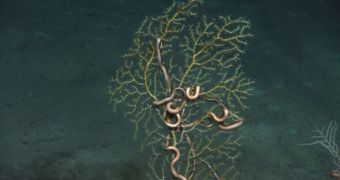Following a 9-day scientific sortie in the Gulf of Mexico, researchers in the United States found extensive damage on coral reef populations. The massive oil spill the began in April spread over a huge surface on top of the water, but also produced massive plumes underneath the waves.
The investigation was conducted by experts at the Woods Hole Oceanographic Institution (WHOI), in Woods Hole, Massachusetts, and was led by chief scientist Charles Fisher.
He holds an appointment as a biology professor at the Penn State University. The state of the corals “reminds me of going to a family funeral,” he says.
The expert says that past trips to the deep sea revealed tremendous biodiversity and healthy ecosystems, populated by a large variety of species that produced intricate food webs.
But the underwater hydrocarbon plumes that were generated by the collapsed Deepwater Horizon drilling rig descended on these area with rage, biologists say, destroying everything in their path.
“Some corals have been severely slimmed. Some are dead or dying,” Fisher explains. He adds that the new investigation was conducted using a research vessel, and also the autonomous underwater vehicle (AUV) Sentry, which is capable of operating at great depth.
Studies were conducted for up to 24 hours each day. The WHOI group photographed and mapped most of the area in the middle of the Gulf, and also collected a multitude of samples for further analysis.
Additionally, an autonomous camera was installed near a reef. This piece of equipment is capable of snapping images once every hour for the next two months. Experts will then use the data to determine whether the reefs are recovering or dying.
But the research effort did not bring only bad news to the surface. Right next to damaged reefs, experts also found corals that appeared unaffected by the oil spill, Our Amazing Planet reports.
“I probably had the happiest experience on the cruise. I got to see the healthy coral,” explains WHOI deep submergence chief scientist Chris German.
The area where the expedition conducted most of its work was located only 7 miles (11 kilometers) away from the original site of the April 20 incident. It was then that the BP drilling rig exploded, killing 11 workers.
The platform itself sunk on April 22, causing the onset of an oil spill larger than the Exxon Valdez oil spill.
“We don't know what's in the most of the Gulf. Just in this one area, the corals we found, the impact was severe. We saw a lot of completely dead corals. A few were doing well, but most were severely impacted,” Fisher explains.

 14 DAY TRIAL //
14 DAY TRIAL //